|
What is a Glass Paperweight?
| By: Paul H. Dunlop, © 2013
Posted January 2014
|
 |
A paperweight is a solid glass sphere with a flattened base, originally made to hold down papers. They may have an internal colored glass decoration, or an incrusted gold, silver or ceramic figure, the best of these being works of art.
A glass paperweight, like any work of art, should be appreciated first for its beauty. Unlike most forms of art, they are meant to be held; for it is with handling, turning them this way and that, letting the magnifying layer of crystal work its magic, that the beauty is revealed in its ever changing possibilities. This is an art form that has a number of dichotomies, each of which helps make paperweights more fascinating.
|
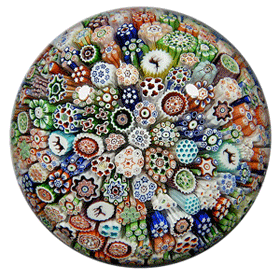
|
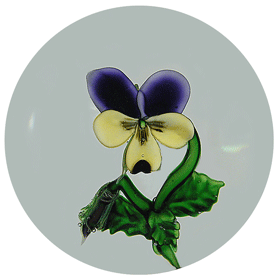
|
|
Baccarat closepack millefiori paperweight with Gridel silhouettes of a goat, dog, horse and a deer set amongst a good variety of colorful geometric canes. Signed and dated “B 1848” in a cane, 2 13/16 inches in diameter.
|
A lampwork pansy set in a clear crystal paperweight; Clichy, ca. 1850, 2 9/16 inches in diameter.
|
The subtle designs and delicate flowers in a paperweight are made of glass, a substance that is hard and solid. This material, glass, is fragile, but also durable, able to last for thousands of years virtually unchanged, if not abused. Paperweights have a form that is functional; yet, they are rarely used for the mundane job of holding down papers. In the mid 1800s, weights were relatively inexpensive, costing the average worker one or two days’ wages. Now, certain rare masterpieces bring prices of well over $100,000.
Although a number of weights sell for astronomical sums, most can be purchased by a collector with a modest budget. Some of the most avid collectors have been kings and queens, yet when Egyptian King Farouk’s collection was sold at auction in 1954, most of the weights were purchased by average collectors.
Paperweights, as an art form, have a relatively short history, slightly over 150 years, and yet little, or in some cases nothing, is known about some of the most important makers.
|
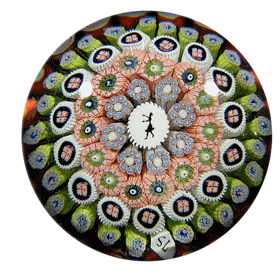
|
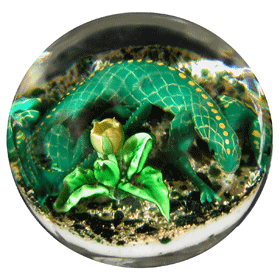
|
|
A close, concentric millefiori paperweight with five rows of canes around a central silhouette cane of a dancing lady. Signed with a cane reading “SL” for St. Louis, ca. 1850, 3-inch diameter.
|
A magnum-sized glass paperweight masterpiece
with a lampwork lizard set on a realistic ground;
Pantin, French, ca. 1878, 4 1/8-inch diameter.
|
Days, weeks, or sometimes months go into preparing a lampwork or millefiori design to be encased in a paperweight, but due to the nature of working with molten glass, an artist has only a matter of minutes to actually encase the design. There are two primary techniques that are used to make a fine paperweight:
*Millefiori—in which a glassmaker uses a variety of molds to make a number of shapes (stars, trefoils, arrowheads, etc.) which are bundled together, heated and drawn out to greatly reduce their size, cut into small pieces, and then arranged into a design to be encased in a paperweight.
*Lampwork—the process of using a small torch to melt colored glass and shape it into small items (leaves, petals, fruit, etc.) which are fused into a desired design and then encased into a weight.
The classic period of paperweight making was during the Victorian Era when other art forms were overly ornate, fussy, gaudy. Paperweights alone remained simple, restrained, elegant. Finally, among the enigmas, is the fact that this tiny work of art, this glass sphere only three inches or so in diameter, when held in the palm of one’s hand, can capture one’s attention for hours and can transport an imagination to another world, another time and over the years offer endless discoveries.
Fine paperweights first appeared in the early to mid-1840s and have been produced intermittently since. The first period, roughly 1845-1870, is called the Classic Period. This is the time when paperweights seem to have been invented simultaneously in several different countries. Although the number of makers was small, there was a virtual explosion of this art form during this period. Within a span of about seven years, all but one of the Classic Period makers had started making weights, most of them starting within the first three years. Only a few factories made weights during these years, but those factories spanned the globe, being in Venice, Bohemia-Silesia, England, France and the United States. It was also during this period that all of the major techniques, still used today, were incorporated into glass paperweights.
|
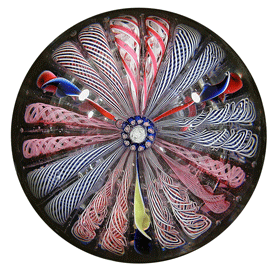
|
A crown paperweight made by New England Glass Company, circa 1860, 2 3/4-inch diameter.
|
Next is a period called the Intermediate Years. Spanning the longest period of time, 1870-1950, there were relatively few fine paperweight makers active. Although the number of weight makers and weights produced was small, the achievements during this time were great. The superb three-dimensional Pantin weights were made during the late 1870s. These flowers, salamanders, fruit and the famous silkworm weights are arguably the finest group of weights ever created. A small number of millefiori weights were made in Russia during the classic period, but the weights most associated with that country, those containing wonderful lampwork, were made in this Intermediate Period.
A few years later, the Mt. Washington roses and strawberries were made. A different kind of three-dimensional weight, the crimp flower, was developed and produced by several glassworkers in Millville, N.J., during the early 1900s.
About the time of the Second World War, the great Scottish artist Paul Ysart and the dean of American paperweight artists Charles Kaziun independently started trying to rediscover the techniques of the classic French paperweights, which had been made 70 years earlier. The success of their individual efforts is largely responsible for the next period, the revival of this almost lost art.
|
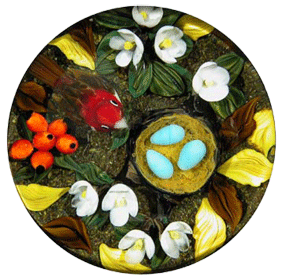
|
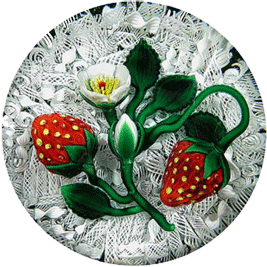
|
|
A Rick Ayotte three-dimensional lampwork paperweight. This weight from 1987 exhibits the wonderful realism which has been accomplished by a handful of glass artists in the past few decades; 3 11/16 inches in diameter.
|
A wonderful lampwork design featuring strawberries
and blossoms on a layer of upset muslin over a deep emerald green ground; James Kontes, circa 1985.
|
This third period, 1950 to date, the Revival, has been an exciting time for the collector. There are more good paperweight artists now than at any other time in history. Technical advances are being made constantly, and though the basic techniques remain the same, there is more variety of artistic expression due to the greater control each artist has over his medium. This is a vital art form, one that celebrates beauty, contrary to many of the other artistic disciplines, which as Dr. Francis Schaeffer1 puts it, “…have fallen below the line of despair.”
Since about 1900, there have been hundreds of people who have made glass paperweights of one type or another. In this group would be the advertising, slogan and tourist shop weights. Most of these are of limited artistic merit at best, and many are downright ugly. Of the millions of glassblowers in the world during this period, perhaps 30 or 40 have been able to make good paperweights. Most collectors are only interested in weights from the best of this small group.
-------------------------------------------
1 Francis A. Schaeffer, The God Who is There, Downers Grove, IL, InterVarsity Press, 1968.
To see interesting videos on how paperweights are made, search “making glass paperweights” on Youtube.
Paul Dunlop and his wife Karen own and operate the Dunlop Collection and Dunlop’s Crystal Vault Gallery in Statesville, N.C., a leading gallery dealing with fine glass paperweights, which has been in business more than 30 years. Their imprint, Papier Presse, has published several titles dealing with glass paperweights and related objects. Their website, GlassPaperweightBooks.com, features almost very book ever printed on the subject.
Before becoming involved with paperweights, Paul was an artist with a number of one-man shows to his credit. His photo-realist paintings appear in numerous leading private and public collections. He has designed two paperweights which were produced by St. Louis.
Paul is the author of three books: Baccarat Paperweights: two centuries of beauty (just released); The Dictionary of Glass Paperweights; and The Jokelson Collection of Antique Cameo Incrustation. He has written numerous articles for the PCA Bulletin and other publications. He curated “Frozen Flame: The Art of Glass Paperweights” at the Phoenix Art Museum in 1991. He may be reached at info@GlassPaperweightBooks.com
Photography by the author, © 2013 Papier Presse.
|